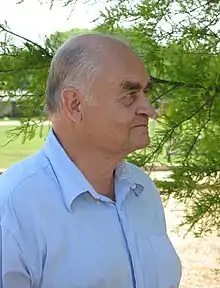Wolfgang Haken
Wolfgang Haken (born June 21, 1928) is a mathematician who specializes in topology, in particular 3-manifolds.
Wolfgang Haken | |
|---|---|
 Wolfgang Haken | |
| Born | June 21, 1928 |
| Alma mater | Kiel University |
| Occupation | Mathematician, professor |
| Known for | Solving the four-color theorem |
Biography
Haken was born in Berlin, Germany. His father was Werner Haken, a physicist who had Max Planck as a doctoral thesis advisor.[1] In 1953, Haken earned a Ph.D. degree in mathematics from Christian-Albrechts-Universität zu Kiel (Kiel University) and married Anna-Irmgard von Bredow, who earned a Ph.D. degree in mathematics from the same university in 1959. In 1962, they left Germany so he could accept a position as visiting professor at the University of Illinois at Urbana-Champaign. He became a full professor in 1965, retiring in 1998.
In 1976, together with colleague Kenneth Appel at the University of Illinois at Urbana-Champaign, Haken solved the four-color theorem. They proved that any two-dimensional map, with certain limitations, can be filled in with four colors without any adjacent “countries” sharing the same color. Haken has introduced several ideas, including Haken manifolds, Kneser-Haken finiteness, and an expansion of the work of Kneser into a theory of normal surfaces. Much of his work has an algorithmic aspect, and he is a figure in algorithmic topology. One of his key contributions to this field is an algorithm to detect if a knot is unknotted.
Haken's eldest son, Armin, proved that there exist propositional tautologies that require resolution proofs of exponential size.[2] Haken's eldest daughter, Dorothea Blostein, is a professor of computer science, known for her discovery of the master theorem for divide-and-conquer recurrences. Another of Haken’s sons, Lippold, is the inventor of the Continuum Fingerboard. Wolfgang is the cousin of Hermann Haken, a physicist known for laser theory and synergetics.
In 1978, Haken delivered an invited address at the International Congress of Mathematicians in Helsinki.[3] He was a recipient of the 1979 Fulkerson Prize of the American Mathematical Society for his solution with Appel of the four-color theorem.[4]

See also
References
- Werner Haken, Beitrag zur Kenntnis der thermoelektrischen Eigenschaften der Metallegierungen. Accessed May 6, 2019
- Avi Wigderson, Mathematics and Computation, March 27 2018, footnote at Theorem 6.11
- International Congress of Mathematicians 1978. International Mathematical Union. Accessed May 29, 2011
- Delbert Ray Fulkerson Prize, American Mathematical Society. Accessed May 29, 2011
- Haken, W. "Theorie der Normalflachen." Acta Math. 105, 245–375, 1961.
External links
- Wolfgang Haken at the Mathematics Genealogy Project
- Haken's faculty page at the University of Illinois at Urbana-Champaign
- Wolfgang Haken biography from World of Mathematics
- Lippold Haken's life story
- Haken, Armin (1985), "The intractability of resolution", Theoretical Computer Science, 39: 297–308, doi:10.1016/0304-3975(85)90144-6
- Appel, Kenneth; Haken, Wolfgang (1989), Every Planar Map is Four Colorable, AMS, p. xv, ISBN 0-8218-5103-9